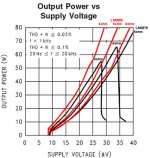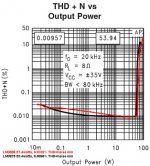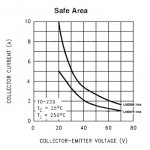Just finished a 3886 GC from one of Brian's kits and it sounds great. Integrated Glassware's attenuator and it made a nice package. Will need a second amp for Tri amp setup and wondered about the LM3875. Anyone care to compare the sound of these two chips?
Thanks,
Pete
Thanks,
Pete
My experience with these devices is limited. Could you expand on what this means in terms of the sound?
Thanx
Pete
Thanx
Pete
i didn't notice notable difference.... i think sound difference could sometimes be derived from ommission of the Ci cap (between resistor from - input and ground on non-inv) that appears on 'reference' 3886 schematics.
Don't recall whether I installed C1 or not, will check and try it both ways. Other than that your feeling is no difference between the two?
Pete
Pete
i believe the 3875 is meant mainly for 8 ohm loads, whereas the 3886 is a little more flexible and handles 4 ohm loads better. i'm about to build a 3875 GC, i'd build a 3886 instead if there were kits available anywhere...
Oh, and not Mute as has been pointed out already. The LM3875 is the no Mute version of the LM3876. If you have no limits on choice or cost then always use LM3886. The only reason to use LM3875 is to save money or if you can't get LM3886.
-SL
-SL
The difference in Power prompted my original question, why use a lower powered device unless there was some sonic advantage? I guess I'll stay with the 3886 since the results of the first unit were so satisfying.
As to the availability of this chip, Parts Express sells them and I believe they are in stock.
Have had no luck trying to raise Brian about soma additional parts and boards, Any one have any info on that?
Thanks to all for their responses
Pete
As to the availability of this chip, Parts Express sells them and I believe they are in stock.
Have had no luck trying to raise Brian about soma additional parts and boards, Any one have any info on that?
Thanks to all for their responses
Pete
LM3886 better in most ways
The 3875 is better in input refered noise by 2.5dB
(-115.8dB vs -113.3dB at 60W into 8ohm)
Because of this the 3875 also has slightly lower THD+noise at low power 20kHz.
However, the actual Harmonic Distortion of the 3886 is lower by about 3dB at most frequency and output power combinations.
So the 3875 is lower noise and the 3886 is lower distortion.
IMO they both already have very low noise and noise is far less irritating than harmonic distortion. So I would consider the 3886 as superior in sonic terms.
The 3886 also puts out more power for any given load or supply voltage,
At 35 volt rails and 8 ohm load:
the 3886 typically puts out ~60Watts
the 3875 typically puts out ~56Watts
As already mentioned the 3886 has the current capability to handle 4ohm loads more efficiently.
Hope this helps🙂
The 3875 is better in input refered noise by 2.5dB
(-115.8dB vs -113.3dB at 60W into 8ohm)
Because of this the 3875 also has slightly lower THD+noise at low power 20kHz.
However, the actual Harmonic Distortion of the 3886 is lower by about 3dB at most frequency and output power combinations.
So the 3875 is lower noise and the 3886 is lower distortion.
IMO they both already have very low noise and noise is far less irritating than harmonic distortion. So I would consider the 3886 as superior in sonic terms.
The 3886 also puts out more power for any given load or supply voltage,
At 35 volt rails and 8 ohm load:
the 3886 typically puts out ~60Watts
the 3875 typically puts out ~56Watts
As already mentioned the 3886 has the current capability to handle 4ohm loads more efficiently.
Hope this helps🙂
I've wondered about the THD+N comparisons that have been used when comparing these two chips.
The fine print in the data sheets indicates that the 3886 was tested at Vcc=+/- 28v and the 3875 was tested at Vcc=+/- 35v. Also, some of the 3886 measurments used 4 ohm loads vs. 8 ohm load for the 3875.
Will some of these differences effect the THD+N measurements??
thanks,
Scott
The fine print in the data sheets indicates that the 3886 was tested at Vcc=+/- 28v and the 3875 was tested at Vcc=+/- 35v. Also, some of the 3886 measurments used 4 ohm loads vs. 8 ohm load for the 3875.
Will some of these differences effect the THD+N measurements??
thanks,
Scott
The Real Deal
Its good to see someone that actually reads the FAQ and spec sheets, not just glance at the 68watts..............
The LM3875 all tested at +/- 35VDC
56watts into 8 ohm load .1%THD
signal to noise ratio greater or equal to 95db 2.0uv noise floor
typical IMD (SMPTE} .004%
THD+N .06%
The LM3886
68watts into 4ohms at +/- 28VDC supply at .1%THD
38watts into 8ohms at +/- 28VDC supply at .1%THD
50watts into 8ohms at +/- 35VDC supply at .1%THD
signal to noise ratio greater or equal to 92db 2.0uv noise floor
typical IMD {SMPTE) .004%
THD+N .03%
So the 3875 puts out 6 watts more at +/-35 as does the 3886 less power I think not
same distortion levels
signal to noise ratio is better 95db to 92db
If you look at the peak current curves are better by .78 amps at the same voltage.
and yes the THD+N is at 28VDC for the 3886 and 35VDC for th 3875.
As for sound quality IMHO the 3875 kicks #$#$#@
and the 3875 is much better for BPA apps when it is doubled up it handles much higher peak outputs almost 20%.
Just my two cents, usually the first is the best😀
Its good to see someone that actually reads the FAQ and spec sheets, not just glance at the 68watts..............
The LM3875 all tested at +/- 35VDC
56watts into 8 ohm load .1%THD
signal to noise ratio greater or equal to 95db 2.0uv noise floor
typical IMD (SMPTE} .004%
THD+N .06%
The LM3886
68watts into 4ohms at +/- 28VDC supply at .1%THD
38watts into 8ohms at +/- 28VDC supply at .1%THD
50watts into 8ohms at +/- 35VDC supply at .1%THD
signal to noise ratio greater or equal to 92db 2.0uv noise floor
typical IMD {SMPTE) .004%
THD+N .03%
So the 3875 puts out 6 watts more at +/-35 as does the 3886 less power I think not

same distortion levels
signal to noise ratio is better 95db to 92db
If you look at the peak current curves are better by .78 amps at the same voltage.
and yes the THD+N is at 28VDC for the 3886 and 35VDC for th 3875.
As for sound quality IMHO the 3875 kicks #$#$#@
and the 3875 is much better for BPA apps when it is doubled up it handles much higher peak outputs almost 20%.
Just my two cents, usually the first is the best😀
🙂
good info, halo0925!
I can add that I have written 10 informative posts in this forum
regarding
LM1875 LM3875 LM3886 and LM4780
lineup on National Overture Chips, like LM3875
http://www.diyaudio.com/forums/search.php
Search string: LM3875 LM3886
Author: lineup
Show results: as posts
.. will give 10 hits, including
/lineup
has got all LMxxxx Datasheets
and they have been studied!
good info, halo0925!
I can add that I have written 10 informative posts in this forum
regarding
LM1875 LM3875 LM3886 and LM4780
lineup on National Overture Chips, like LM3875
http://www.diyaudio.com/forums/search.php
Search string: LM3875 LM3886
Author: lineup
Show results: as posts
.. will give 10 hits, including
http://www.diyaudio.com/forums/showthread.php?postid=825339#post825339Re: What are the differences between the 3875, 3886, and 4780?
Is it just power output?
Reply: -------------------------------------------------------
no it is not just power
LM3875 is a very good and stable IC for 4/8 Ohm.
Good for first project, to get some experience.
I prefer the standard setup schematic in datasheet.
You've got to love this IC!
LM3886 can put out more current than LM3875, almost twice as much,
before Current Limit is activated (SPiKe protection).
This makes LM3886 better suited for 4 Ohm at higher powers.
LM3886 is also faster than LM3875.
Higher slewrate. (If you are unlucky you can get oscillation.)
LM4780 is judging from data two LM3886 in same chip.
This gives a bit reduced high power performance, compared to two LM3886.
Mainly because 2 chips can cool better, than one chip. (Larger cooling surface)
.
http://www.diyaudio.com/forums/showthread.php?postid=793301#post793301Gainclone vs. Nelson Pass A40
Reply:
Gainclone, using LM3875 or LM3886,
is much better project for absolute beginners.
Many people want to build something they can easily understand.
Easier to find parts. Cheaper.
I would imagine LM3875 can be found most everywhere in the world.
How about heatsink and trafo.
Doesnt these A40 parts cost much more?
Surely there are a lot more reasons in favour of LM3875 amp.
Not to say A40 may be a bad amp.
No way!
.
/lineup
has got all LMxxxx Datasheets
and they have been studied!
I'll put a vote in for the LM3875. I can't say why exactly but I prefer the sound of my LM3875 GCs to the LM3886 varieties that I have built!
I like the idea of paralleling the LM3875 too - I did say 'enough' but that could probably be my next GC project! 😉
I like the idea of paralleling the LM3875 too - I did say 'enough' but that could probably be my next GC project! 😉
I will also put my vote for LM3875, otherwise I wouldn't be using that op amp exclusively for last 3 years. Also, the input from people who tried both, indicate that LM3875 is preferred when pure listening satisfaction is what matters at the end of a day.
Graphs frpom national data
This graph shows the safe operating area of the LM3886 and 3875 for 1 millisecond.
It shows that the LM3886 has a much greater peak power dissipation capacity at the output transistors and demonstrates that this amp is much more rugged.
This graph shows the safe operating area of the LM3886 and 3875 for 1 millisecond.
It shows that the LM3886 has a much greater peak power dissipation capacity at the output transistors and demonstrates that this amp is much more rugged.
Attachments
- Status
- Not open for further replies.
- Home
- Amplifiers
- Chip Amps
- Lm3875 Vs Lm3886



